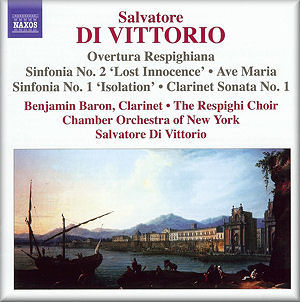 |
 |
|


alternatively
CD: MDT
AmazonUK
AmazonUS
Sound
Samples & Downloads |
Salvatore DI VITTORIO
(b.1967)
*Overtura Respighiana (2008) [5:38]
*Sinfonia no.2 'Lost Innocence' (1997/2000) [14:20]
Ave Maria, for female chorus (1995/1998) [7:46]
*Sinfonia no.1 'Isolation', for string orchestra (1994/1999) [20:24]
Sonata no.1, for solo clarinet (1995/1998) [8:44]
 Benjamin Baron (clarinet)
Benjamin Baron (clarinet)
Respighi Choir
*Chamber Orchestra of New York 'Ottorino Respighi'/Salvatore Di
Vittorio
rec. Performing Arts Center, Adelphi University, New York, 15-16
February, 24-25 May 2010. DDD
 NAXOS 8.572333 [56:52]
NAXOS 8.572333 [56:52] 
|
|
|
Ottorino Respighi's unfinished Violin Concerto in A was elaborated
and completed - at the request of Respighi's family, no less
- by Italian composer Salvatore Di Vittorio. He conducted Laura
Marzadori with the awkwardly-named Chamber Orchestra of New
York 'Ottorino Respighi' in the Concerto's world premiere performance
early in 2010. He presided again in its first recording. The
sessions took place a few weeks later at the same fixture as
this disc of Di Vittorio's own works. It was released on Naxos
this summer only a month after the Respighi disc - about which,
see review.
Clearly, Di Vittorio has an affinity with Respighi, and indeed
the blurb for this release describes him as "hailed by
critics as 'following in the footsteps of Respighi'". The
CD thus opens appropriately with the Overtura Respighiana,
a light, cheery piece that "fuses Rossini's influence on
Respighi with both of their influences on Di Vittorio’s own
musical language". Not exactly a work of genius, but pleasant
enough - yet marred by Naxos's poor editing, cutting short by
a fraction of a second the dying reverberation of the work's
final chord, a spectre which looms again, and much larger, later
on in the programme - see below.
The Sinfonia no.2 is more interesting, although perhaps a bit
lightweight-sounding to follow right after the Overture. Given
its fairly reflective, sometimes even upbeat nature - the second
movement 'Dance of Tears' never quite manages to come across
as ironic - it is a surprise to learn that the work was "inspired
by the tragedy of the Yugoslav civil wars in the late 1990s".
"Inspired" is perhaps not the best word in the circumstances,
and the Dayton Agreement ended four years of civil war in 1995.
Despite passages of genuine drama in the third and fourth movements,
the music generally refuses to weigh itself down with gravitas,
instead shaking off the gloom and doom of the section titles.
It leaves the listener feeling more hopeful about the future
than any witness to the mindless brutality of those wars had
a right to be.
Incidentally, both Sinfonias on this CD are symphonies, and
it might have been less confusing for Naxos to label them as
such, rather than use the Italian word which has other connotations
in the English-speaking world.
The Ave Maria, for a cappella female chorus, provides
a rather incongruous but pleasing interlude. Di Vittorio writes
that it "attempts to capture the essence and spirit of
all that is womanhood", which seems a rather extravagant
claim. It is nevertheless attractive and approachable, something
like a 19th century rewriting of a Renaissance motet. The nine
voices of the Respighi Choir sing very nicely, even if they
do not necessarily live up to the composer's stated hopes!
The four-movement Sinfonia no.1, written for strings alone,
is a longer and altogether more profound work than no.2. Indicatively
subtitled 'Isolation', Di Vittorio describes it as a programmatic
work, based on folksongs, which expresses "human emotional
and spiritual longing, man's longing for his enlightened inner
self." Certainly there is much that is philosophically
brooding or elegiac, particularly the first two movements. The
overall mood tends towards melancholy, but the music is still
far from bleak, as if golden sunshine were threatening to break
through the grey clouds at any moment. Things take a more positive
path in the second half of the work, with a mellow final movement
that is more Tchaikovsky than Respighi. Both Symphonies and
the Ave Maria have been recorded once previously, on a live
disc released by Italian label Panastudio in 2000 (CDC1068-2).
Unfortunately, the Naxos recording goes to pot in the last 15
seconds of the third movement, with flickerings of volume that
suggest the producer's cat suddenly ran across the faders, and
there is more unwelcome technical meddling in the final movement.
Naxos can probably correct these faults online easily enough,
but it is still surprising that such things are not picked up
in quality control before the expensive business of publishing
CDs.
The Chamber Orchestra of New York 'Ottorino Respighi' is still
very young, created by Di Vittorio in 2006. There is a certain
greenness to their performance in the two Symphonies and the
Overture - not bad, by any means, but a little 'unbuttoned'
at times.
Finally, and again somewhat at odds with the orchestral music,
comes the Sonata no.1, for solo clarinet. Di Vittorio has written
a Sonata no.2 since, but it is for piano - in other words, this
may be the only Sonata for solo clarinet he will produce. That
would be a pity, because, although short and simple, it is an
immediately appealing, expressive yet introspective three-movement
work (moderato, pił mosso, moderato). It would surely make a
lovely encore for any clarinettist and is soulfully played here
by Benjamin Baron.
Sound quality is generally good, with a slight mark-down for
the first three works, in which the microphones have not performed
as well as elsewhere, leading to a slight lack of definition
in the highest registers and volumes. There is very faint traffic
noise audible only very occasionally. The CD booklet is the
usual slim-but-informative effort, with notes by Di Vittorio,
who is pictured looking Italian.
Byzantion
Collected reviews and contact at reviews.gramma.co.uk
|
|

